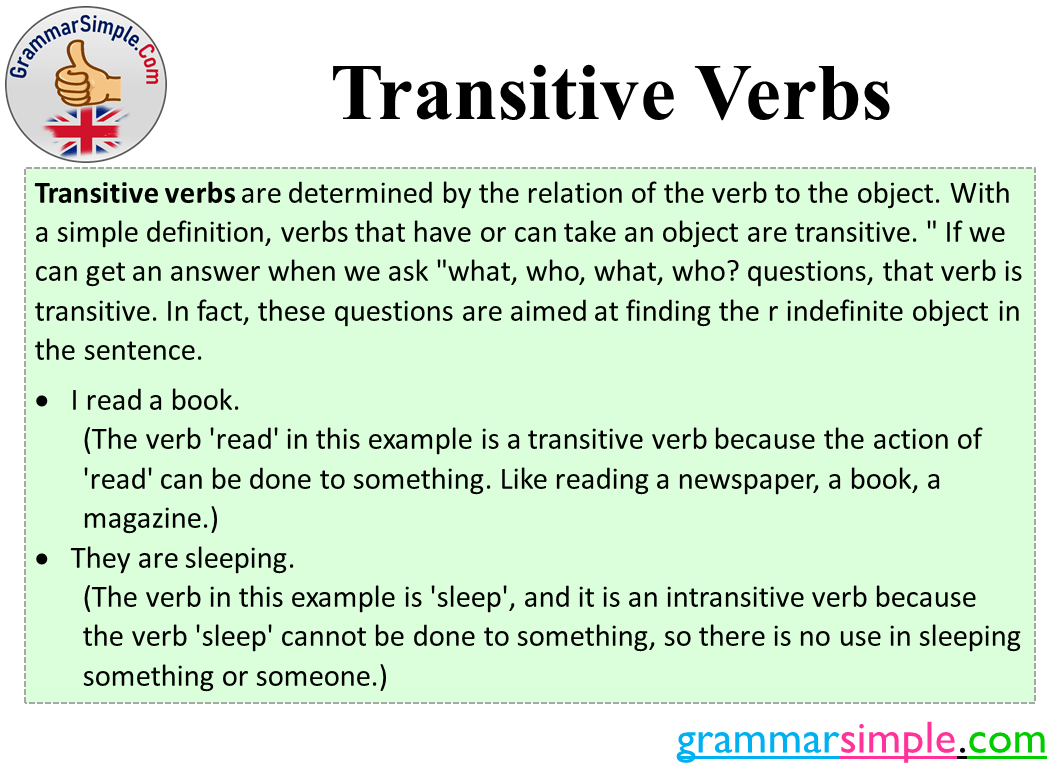What is Transitive Verb? Transitive Verbs Example Sentences


What is Transitive Verb? Transitive Verbs Example Sentences
Table of Contents
Transitive Verb
Transitive verbs are determined by the relation of the verb to the object. With a simple definition, verbs that have or can take an object are transitive. ” If we can get an answer when we ask “what, who, what, who? questions, that verb is transitive. In fact, these questions are aimed at finding the r indefinite object in the sentence.
- I read a book.
(The verb ‘read’ in this example is a transitive verb because the action of ‘read’ can be done to something. Like reading a newspaper, a book, a magazine.)
- They are sleeping.
What is Intransitive Verb? Intransitive Verbs Example Sentences
(The verb in this example is ‘sleep’, and it is an intransitive verb because the verb ‘sleep’ cannot be done to something, so there is no use in sleeping something or someone.)
Here are some other examples:
- He was meticulously examining the writings in his hand.
- He placed the flowers he collected in a vase.
- My father used to buy the newspaper on Sunday mornings.
- He also invited his cousin to the graduation ceremony.
- Our teacher used to tell us jokes in class.
- You can’t notice it if you don’t look carefully.
- He fixed the broken TV immediately.
- I bought fruits and vegetables from the market.
- He would break the onion with his hands and eat it.
- I hear
- I know you understand me.
- Can you give me the book?
- I love you so much.
- His brother broke his pencil.
- We watched a good movie in the evening.
- In the evening he turned on the lamp.
- I bought him a nice gift.
- They cut down the dried trees in the garden.
- I forgot my books at home.
- He watched the game last night.
- We sat on the beach at night and played guitar.
- He painted the aging walls of the school during the summer vacation.
- He wrote down his teacher’s words in his notebook.
- He transferred his earnings abroad to his home account.
- He heard the dogs howling before the earthquake.
- I really like apples because they are very good for your health.
- I feed my dog every day twice.
A Guide to Recognizing a Transitive Verb
Transitive verbs both can take and require objects. The sentence in which a transitive verb is found will appear incomplete if the verb does not have an object to impact.
“Please send a copy to me.”
The transitive verb send is used in this sentence, and its object is copy, which is the thing that is being sent. This verb will not make sense unless it has some sort of object attached to it.
“Please send.”
What should I send, and who should I send it to? Because the meaning of the word send necessitates it, the question begs itself.
Another example of transitive verbs and their objects can be:
- Alice hurled the book in my direction.
Each of the verbs is followed by an object. If the objects were removed from the sentence, the results would be irrational, and the reader’s mind would be filled with more questions.
Recent Posts
Use Rose in a Sentence, How to Use Rose with Example Sentences
Use Rose in a Sentence, How to Use Rose with Example Sentences
Use Yourself in a Sentence, How to Use Yourself with Example Sentences
Use Yourself in a Sentence, How to Use Yourself with Example Sentences
Use Picture in a Sentence, How to Use Picture with Example Sentences
Use Picture in a Sentence, How to Use Picture with Example Sentences
Use Claim in a Sentence, How to Use Claim with Example Sentences
Use Claim in a Sentence, How to Use Claim with Example Sentences
Use Treasure in a Sentence, How to Use Treasure with Example Sentences
Use Treasure in a Sentence, How to Use Treasure with Example Sentences
Use Raise in a Sentence, How to Use Raise with Example Sentences
Use Raise in a Sentence, How to Use Raise with Example Sentences